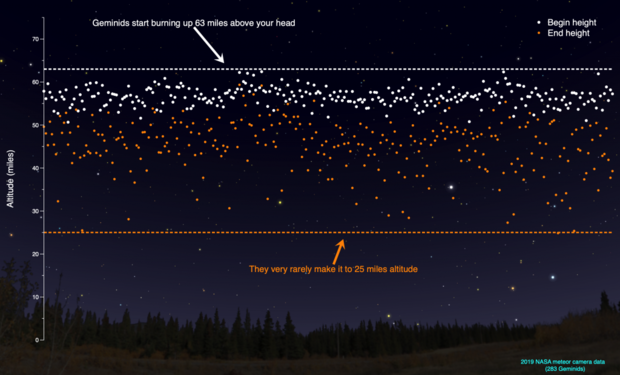The Geminids meteor shower could reveal up to 120 meteors per hour flying through the sky tonight. Here's how to watch.
The night sky will be illuminated tonight with the bright yellow streaks of what NASA calls "one of the best and most reliable" meteor showers of the year.
The Geminids meteor shower occurs every year for several weeks. This year, it started on November 19, but it isn't until tonight and Wednesday that it's set to peak with about 120 meteors zooming through space every hour in "one of the major meteor showers of the year," according to NASA.
Here's everything you should know for a picture-perfect evening under the stars – and rocks.
What is it?
The iconic Geminids meteor shower got its name because of its location. The meteors appear to come from the Gemini constellation, easily identifiable by its two most prominent stars, Castor and Pollux, which are often identified as the "heads" of the Gemini twins referenced in Greek mythology.
But it's important to note that the constellation itself is not the source of the meteors. Rather, they come from the 3200 Phaethon asteroid, which has a "comet-like" elliptical orbit around the sun every 1.4 years. From that asteroid, the flying rocks travel at 78,000 miles per hour, according to NASA – more than 40 times faster than a speeding bullet. But don't worry about getting hit by one, as they tend to start burning up about 63 miles above your head.
How to watch
While peak activity will display 120 meteors flying through space, that full number is only visible in "perfect conditions," NASA said. The shower is expected to begin Tuesday night and last until dawn, with optimal viewing during the night and predawn hours.
The predicted peak may be more difficult for those with early sunrises, as EarthSky anticipates that it will happen around 8 a.m. EST on Wednesday.
The best way to watch it all unfold is to find a spot outside away from lights.
"Lie flat on your back with your feet facing south and look up, taking in as much of the sky as possible," NASA says. "After about 30 minutes in the dark, your eyes will adapt and you will begin to see meteors. Be patient – the show will last until dawn, so you have plenty of time to catch a glimpse."
What to expect
Many people setting out to watch tonight's meteor shower won't be able to see its full extent. The moon is currently in a waning gibbous phase, NASA said, which will make it more difficult for people in the northern hemisphere to see most of the shower. As such, it's likely that only 30 to 40 visible meteors will be seen every hour, depending on sky conditions.
But according to EarthSky, "all is not lost" – the moon won't finish rising until closer to midnight, providing more opportunities to see the shower unfold.
"The Geminids are so bright that this should still be a good show," NASA said earlier this month.
To help get the most out of the meteor shower, NASA's Bill Cooke suggests sitting in the shade of a house or tree with a view of the open sky to help shield the view from the moon's glow. It's also recommended that people should avoid looking at the Gemini constellation, from which the shower gets its name, because the meteors themselves have "very short trails and are easily missed," NASA said.
"However, tracing a meteor backwards to the constellation Gemini can determine if you caught a Geminid," the agency added.





